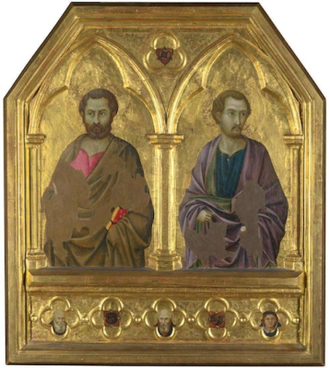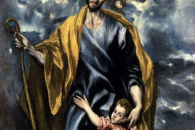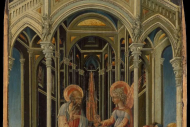Gospel in Art: Feast of Saints Simon and Jude, Apostles

Saints Simon and Thaddeus (Jude), by Ugolino di Nerio, Painted 1325-1328 © The National Gallery, London
Source: Christian Art
Gospel of 28 October 2024
Luke 6:12-19
Jesus went out into the hills to pray; and he spent the whole night in prayer to God. When day came he summoned his disciples and picked out twelve of them; he called them 'apostles': Simon whom he called Peter, and his brother Andrew; James, John, Philip, Bartholomew, Matthew, Thomas, James son of Alphaeus, Simon called the Zealot, Judas son of James, and Judas Iscariot who became a traitor.
He then came down with them and stopped at a piece of level ground where there was a large gathering of his disciples with a great crowd of people from all parts of Judaea and from Jerusalem and from the coastal region of Tyre and Sidon who had come to hear him and to be cured of their diseases. People tormented by unclean spirits were also cured, and everyone in the crowd was trying to touch him because power came out of him that cured them all.
Reflection on the painting
In the 4th century, legends began to circulate regarding Saints Simon and Jude's missionary work in Mesopotamia and Persia. According to the apocryphal Passion of Simon and Jude, both were martyred there. Since the 8th century, the Church has commemorated their feast day together on 28 October. Simon is listed as the tenth apostle in Luke's account of the apostles, as we hear in today's reading, though little else is known about him. In art, Saint Simon is traditionally depicted with a saw, the instrument of his martyrdom. Saint Jude, also known as Thaddaeus, is remembered for asking Jesus, during the Last Supper, why he chose to reveal himself only to the disciples and not to the world. According to tradition, Saint Jude was martyred around 65 AD in Beirut, killed with an axe. He is venerated as the patron saint of lost and desperate causes.
Our painting by Ugolino di Nerio, once part of a larger altarpiece for the Florentine church of Santa Croce, depicts these two apostles together. Though damaged, the inscription identifying the saint in violet as "S.THA." (Saint Thaddeus) is still faintly visible to the left of his halo. Although the inscription naming the other saint has disappeared, it is almost certainly Simon. Beneath the apostles, decorative quatrefoils display images of two older bearded men and a younger, beardless man, possibly friars from the Franciscan Order who lived at Santa Croce.
An old tradition associated with this feast day involves preparations for the Feast of All Souls. Christians would bake items such as 'bread of the dead'-a tradition particularly beloved in Mexico, where it is known as 'pan de muerto'-and 'soul cakes'. In some regions, people would go door to door on this day, gathering ingredients to make these cakes in anticipation of All Saints' and All Souls' Day celebrations.
LINKS
Gospel in Art: https://christian.art/
Today's Reflection: https://christian.art/daily-gospel-reading/luke-6-12-19-2024-2/


















